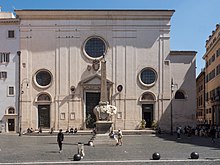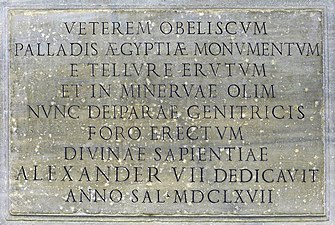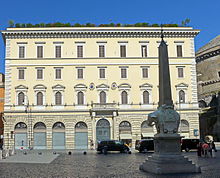Piazza della Minerva
| Piazza della Minerva | |
|---|---|
| Place in Rome | |
 Piazza della Minerva with the Pantheon in the background |
|
| Basic data | |
| place | Rome |
| District | Rione Pigna |
| Confluent streets | Via della Minerva, Via di Santa Caterina da Siena, Via dei Cestari, Via di Santa Chiara, Via Palombella |
| Buildings | Santa Maria sopra Minerva , elephant with the obelisk , Library of the Italian Senate , Pontifical Diplomatic Academy |
| use | |
| User groups | Pedestrian traffic , bicycle traffic |
The Piazza della Minerva is a square in the historic center of Rome , Italy, in the Rione Pigna , southeast of the Pantheon . The church of Santa Maria sopra Minerva is right on the square . In ancient Rome there was a round temple of the goddess Minerva to the east of the square . The square and the church were named after this temple in the Middle Ages.
plan
The structures identified by the numbers 1 to 5 are explained below.
Buildings
Santa Maria sopra Minerva (1)
The church of Santa Maria sopra Minerva with its simple facade dominates the square. It is the only Gothic church in Rome and a Dominican religious order. It contains a large number of works of art and tombs of important personalities; among other things, it is the burial place of five popes. As early as the 8th century, a church of Santa Maria in Minervio can be found on this site . On the right of the facade of the side chapels are the high water marks of the Tiber (Fig.) From the years 1422 to 1598 - the area is the lowest in Rome and has therefore been repeatedly affected by floods.
Bernini's Elephant with Obelisk (2)
In the center of the square, with the back facing the Inquisition building, there has been a curious monument since 1667: Bernini's elephant . The elephant carries one of the eight ancient Egyptian obelisks in Rome , called Obelisco della Minerva , after its place of discovery in the temple or church area. Pope Alexander VII (see inscription A) commissioned Gian Lorenzo Bernini to design the sculpture, which Ercole Ferrata implemented. The papal coat of arms is attached to the base of the monument. The elephant, an ancient symbol of strength, wisdom and piety, should embody those virtues that support true Christian teaching (see inscription B).
Translation of inscription A: “This old obelisk, a monument to the Egyptian Pallas [= Isis], dug out of the earth and erected on the site, formerly Minerva, now the godlike Mother of God, was consecrated by Alexander VII to Divine Wisdom in the year of salvation in 1667 . "
Translation of inscription B: “The symbols carved on the obelisk by the wise men of Egypt that you see here; carried by an elephant, the strongest of the animals, take it as evidence that a strong spirit sustains healthy wisdom. "
Library of the Italian Senate (3)
Next to the church, the monastery complex (casa professa) of the Dominican Order was built in the 13th century, which over time expanded to Via del Seminario and the Church of San Macuto. Since the 17th century, the monastery was the seat of the Roman Inquisition , the Sacra Congregatio Romanae et universalis Inquisitionis or Congregatio Sancti Officii . There was Galileo Galilei made in 1633 of the process.
In 1870 the new state of Italy took over the buildings, renovated them and used them for the Ministry of Education and a short time later for the Ministry of Post and Telecommunications. Today it houses the library of the Italian Senate , dedicated to the historian and Italian politician Giovanni Spadolini . The largely restored, adjacent cloister is still in the possession of the Dominican Order to this day.
Pontifical Diplomatic Academy (4)
Across from the church, the Palazzo Severoli has housed the Pontifical Diplomatic Academy ( Pontificia Accademia Ecclesiastica - formerly Accademia dei Nobili Ecclesiastici ) since 1706 . The building originally dates from the 14th century and was completely renovated in 1878. The diplomats of the Vatican State are trained in the Pontifical College.
Hotel Minerva (5)
To the right of the church is the 17th century Palazzo Fonseca, originally owned by the Fonseca families , then the Conti . In 1832 the palazzo was converted into one of Rome's historic hotels, called the Minerva. The first hotel business goes back to the French Joseph Sauve. He bought the palace at the beginning of the 19th century and turned it into a luxury inn. The Hotel Minerva was already listed in a hotel directory from 1855. Among the illustrious guests were among others from the clergy Pope Pius IX. and a large number of cardinals as well as artists and writers such as George Sand and Stendhal , to whom a plaque at the entrance is dedicated. There was even a chapel in the house where mass could be read. The last major restructuring took place in 1924.
Historical topography
In ancient Rome, the area of today's square belonged to the Field of Mars , located outside the Pomerium , where foreign cults were also allowed to build their temples. The general Pompey Magnus began to settle this district and Emperor Augustus selected him for the building development and renovation of the city. Marcus Vipsanius Agrippa had the Saepta Julia and the thermal baths of Agrippa built there, as well as the basilica of Neptune, the portico of the Argonauts and - outstandingly - a forerunner of today's Pantheon . The square and the Basilica of Santa Maria sopra Minerva are located above the ruins of the Saepta Julia.
On the side of the square behind the Pantheon, where the Pontifical Diplomatic Academy is located today, there was probably a large water basin (Stagnum Agrippae) belonging to the Agrippa thermal baths. East of the Saepta Iulia, towards the current church of Sant'Ignazio, were an Isis temple, a Serapis temple and a round temple, which Pompeius Magnus presumably had consecrated to the goddess Minerva Chalcidica.
literature
- Marco Bussagli: Rome, Art & Architecture. Krönemann Verlag, Cologne 1999, ISBN 3-8290-2258-1 .
- Heinz-Joachim Fischer : Rome. A travel companion. DuMont Art Guide, DuMont Buchverlag, Cologne 1989, ISBN 3-7701-1991-6 .
- Stefan Grundmann (Ed.): Architectural Guide Rome. Edition Axel Menges, 1997, Stuttgart / London, ISBN 3-930698-59-5 .
- Ursula Kleefischer-Jobst: The Roman Dominican Church of Santa Maria sopra Minerva. A contribution to the architecture of the mendicant orders in central Italy. Nodus publications, 1991, Münster.
- Mauro Lucentini: Rome. Paths to the city. Pattloch Verlag, Munich 2000, ISBN 3-629-01621-9 .
- Claudio Rendina: Le Chiese di Roma. Newton Compton Editori, Rome 2007, ISBN 978-88-541-0931-5 .
- Filippo Coarelli : Rome. An archaeological guide. Philipp von Zabern, Mainz 2000, ISBN 3-8053-2685-8 , pp. 258-301.
- Amanda Claridge: Rome. To Oxford Archaeological Guide. Oxford University Press, New York 2010, ISBN 978-0-19-954683-1
Individual evidence
- ↑ Filippo Coarelli: Rom , pp. 284 ff.
- ↑ Itinerarium Einsidlense
- ^ Samuel Ball Platner, Thomas Ashby: Thermae Agrippae in: A Topographical Dictionary of Ancient Rome (English)
- ^ Samuel Ball Platner, Thomas Ashby: Aedes Isidis (Isistempel) in: A Topographical Dictionary of Ancient Rome (English)
- ↑ Samuel Ball Platner, Thomas Ashby: Minerva Chalcidica in: A Topographical Dictionary of Ancient Rome (English)
Web links
- Illustrations and brief descriptions of Piazza della Minerva. (English)
- Churches of Rome - Santa Maria sopra Minerva. (engl.)
- SB Platner, Th.Ashby: A Topographical Dictionary of Ancient Rome
Coordinates: 41 ° 53 ′ 53.3 " N , 12 ° 28 ′ 38.4" E








